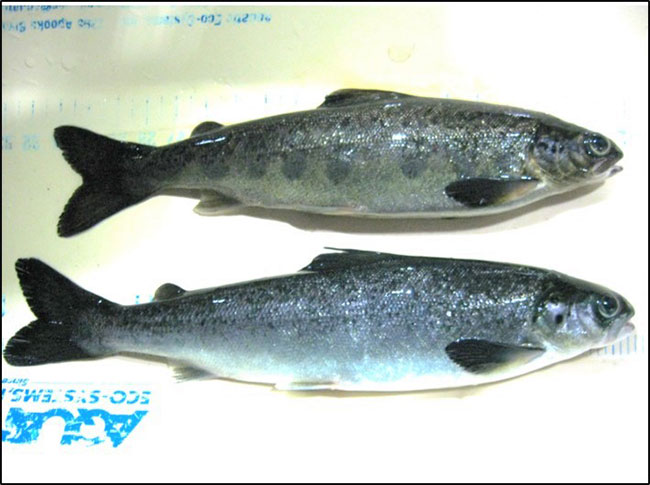
Features
post-smolt
Research
Fresh Tips: Considerations for induced smoltification
July 31, 2023 By Curtis Crouse, Freshwater Institute
 An Atlantic salmon parr (top) and an Atlantic salmon smolt (bottom)
Photo: Freshwater Institute
An Atlantic salmon parr (top) and an Atlantic salmon smolt (bottom)
Photo: Freshwater Institute As anadromous fish, Atlantic salmon undergo a physiological change as they migrate from freshwater to seawater. This process, known as smoltification, prepares the fish for the seawater environment and leads to a fast growth phase of life. Knowing the smoltification status of young Atlantic salmon is critical for farming operations to properly time the movement of stocks from freshwater nursery systems to sea cages or saltwater grow out systems.
Young Atlantic salmon can be provided with a short artificial winter photoperiod (AWP) to control the timing and synchronization of smoltification leading to better fish health outcomes when moved to seawater. AWP is also a useful tool to create out-of-season salmon smolts for consistent production volume.
The Freshwater Institute (FI) has demonstrated the feasibility of raising Atlantic salmon from eyed egg to market size exclusively in freshwater. Despite remaining in freshwater, Atlantic salmon at FI are typically provided with an AWP to induce smoltification, though several previous cohorts have performed well and smoltified normally without the benefit of an AWP. When providing AWP for smoltification, there are several considerations for successful application.
Lighting
Each nursey tank at FI has a dedicated dimmable 5,000K LED light suspended approximately three feet above the tank surface. Newly ponded fry are provided a 24-hour light photoperiod from the first feeding to the onset of the AWP. The AWP typically begins when fish reach approximately 40 grams of average weight. The light over the nursery tank is then programmed to provide 12 hours of light and 12 hours of dark for 6-8 weeks, followed by a return to 24 hours of light.
It is important that the tanks are only receiving light from the dedicated source during the AWP. At FI, each nursery tank is enclosed with a lightproof tent to prevent overhead ambient room light from influencing the intended photoperiod. Tanks could also be fitted with a lid or other cover or situated in a dedicated room with its own overhead light. In any scenario, make sure that light cannot penetrate the enclosure or shine through seams or joints in materials or walls.
When deciding on a lighting control system there are several features to consider. The first attribute should be ease of use. A second consideration is the number of channels available.
The farm’s bioplan, may dictate a need to provide several tanks with different photoperiods at the same time. A single light controller with multiple channels can be programmed to provide the desired photoperiod when needed. A good light controller should also be capable of gradually increasing and decreasing light intensity at the start and end of daylight hours.
The gradual change in intensity can reduce startle reflexes and stress associated with the light abruptly turning on and off from full intensity. A compatible dimmable light is needed for this feature. Fade up and down should occur over a 30- to 60-minute time block. Customizable on and off times also allow farms to sync daylight hours of the AWP with work schedules so that health observations, tank maintenance, and cleaning can be completed while the tank is illuminated, and dark hours are not disturbed by opening enclosures.
If a light intensity logger is not available, it can be helpful to schedule on-time at the start of a shift or off-time at the end of a shift so that technicians can confirm that the lighting is turning on and off as intended.
Feeding
Salmon reared at the FI are typically fed around the clock with equally spaced feeding events administered with automatic feeders. Waste is monitored with collection in an external settling tank to gauge fish satiation. The external settling tank allows technicians to assess waste feed and feces production without having to open the light-proof enclosure.
While under the AWP, feed programming is adjusted to deliver feed during light hours only, as feeding during dark usually results in excessive feed waste from reduced capture efficiency. Feeding is also avoided in close proximity to lights turning on and off each day. Salmon are still fed to satiation while under AWP, however, the abbreviated feeding window typically results in a reduced total daily ration compared to fish fed over the full day.
Handling
At the completion of the AWP, pay close attention to the fish as this can be a stressful transformation, especially when seawater-ready fish are to remain in freshwater. In this case, FI refrains from moving or handling newly smolted fish for at least six weeks after the completion of the AWP. To prevent unnecessary fish handling during this time window, begin with an appropriate fish stocking density, such that the growing fish do not exceed the carrying capacity of the tank when the AWP and resting period are complete.
Print this page